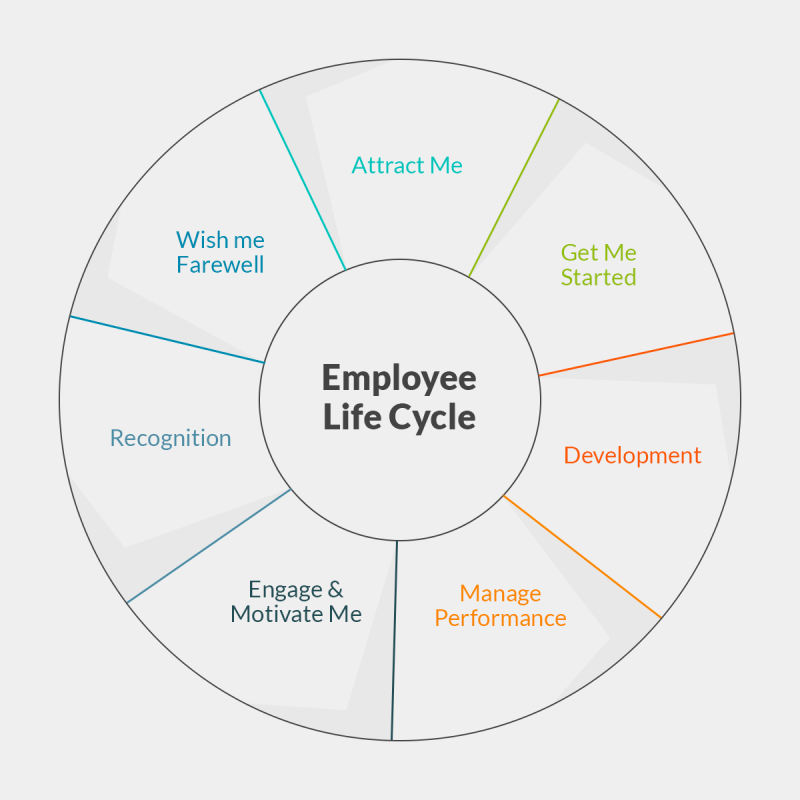The employee life cycle is frequently associated with the product life cycle and marketing campaigns. The management of personnel is based on the employee life cycle. This is a model that represents the entire journey of an employee in the company from the moment of recruitment to his leave. The length of the employee life cycle is closely related to the style and methods of personnel management, organizational culture, and atmosphere at work. The efficient staff policy relies on the employee life cycle that has to be consciously planned. The scheme enables rational management of employee retention and minimalizes potential losses connected to the recruitment process.
Employee life cycle – table of contents:
- Employee life cycle
- Recruitment
- Hiring and onboarding
- Professional development
- Retention of employee
- Leaving
- Summary
- Check out Firmbee to stay up to date with your employees’ responsibilities
Employee life cycle
The starting point of the employee life cycle is the individual hired by the company. This person is obliged to work for the organization under a contract of employment. The employer completes tasks and receives the salary. The employee life cycle is a specific model that consists of the subsequent stages of employment and functioning in the company.
From the point of view of the staff management strategy, the analysis of the employee life cycle has a strategic meaning. The knowledge about the employment stages enables fast reaction of the management team in the situation of crisis. In addition, the cycle helps to perform the analysis of the effectiveness and engagement levels of employees.
The stage in the employee life cycle determines the motivational solutions. In the practice of business, the stages of the cycle are defined in many ways. The most popular is the division of the cycle into five stages that include: recruitment, employment, adaptation, professional development, retention and leave. Those stages are sometimes called differently, but the mere concept stays always the same.
Recruitment
To attract valuable employees organizations should make a name for themselves. Employees should believe that the company is a good employer. The key aspects of this issue are related to the organizational culture, professional development, and motivational system. From the point of view of the employee, the stage of recruitment encompasses the search for information about available workplaces and applying for interesting job posts.
The most important source of information about the company is the internet with the own company websites, online adverts, job adverts on job portals, referrals from friends, and comments on social media. At this stage, the employee decides to join the selected company, while the employer chooses the candidate for the next recruitment stage. When the candidate accepts the job offer the stage of recruitment is finished.
Hiring and onboarding
The second stage of the employee life cycle is the employment and onboarding stage. The agreement is signed and the employee has to be familiarized with his duties. The newly employed individuals have dedication and devotion, they learn willingly and eagerly take up challenges. At this phase, the employees make their decision if they wish to stay with the company or leave – the onboarding process is very important at this point – it is successful the company has a chance to keep the employee within the organization.
The adaptation of the employee should be realized both in the professional and social dimensions. One cannot forget that interpersonal relations and organizational culture have important meanings and frequently are the determining factors that influence the decision about the continuation of employment. Moreover, the employee should be familiarized with the goals, mission, vision, and values of the organization to be able to relate to the company and its aims.
Professional development
The process of adaptation of the newly employed person takes usually from three to six months. After this time the employee already knows his duties, understands the tasks, and knows the structure and culture of the organization. After the next several months there is a time for professional development. It is the moment when the expectations of the employer and the abilities of the employee clash. It is beneficial to check if there is a need to implement any type of training. At this stage, the career path should be set out.
The basic function of professional development is the acquisition of new knowledge. Professional development is one of the main motivational tools hence it should be taken care of and be included in the personal strategies of each employee. The investment in the professional development of the employees usually helps the company and increases its role in the labor market. The employee well cared for should not think about the change of employment and going to the competition.

Retention of employee
The retention of employees is one of the longest the most difficult stages in the employee life cycle. After several years of working the effectiveness and involvement usually decreases. The employee is convinced about his position in the company and becomes a specialist in his field. At this stage, it is crucial to motivate the employee and encouragement to take up new challenges.
It is worth providing adequate financial incentives as well as the right working conditions, freedom to decide, and the ability to learn and draw conclusions. The most important factor that influences the decision on staying in employment is the security of employment and the organizational culture based on mutual respect, partnership, and cooperation.
Leaving
The last stage of the employee’s life cycle is his departure from the organization. It has to be remembered that offboarding is equally important as recruitment and onboarding. Partying with an employee is usually a key moment for both parties and poses threats to the company such as the creation of a competency gap, organizational chaos, decrease in efficiency.
From the perspective of the employee, the most stressful is the fact of losing stability and the potential worsening of his living situation. Therefore the process of offboarding is so important. The more organized and orderly the process is the more efficient the passing of the responsibilities.
Well-organized offboarding diminishes the risk of crisis. In extreme cases of employees leaving it is necessary to streamline the processes to avoid organizational paralysis. It is worth remembering that talented employee that leaves the company should have the possibility to come back to the organization.
Summary
The manager of the HR department plays a key role in employee life cycle management. At the first stage of the cycle, the manager should control the effectiveness and motivation of personnel. The next stage of retention is the most demanding and requires adequate and precise operations. The stage cannot be neglected because there is a huge risk of losing key talents.
Particularly important are the activities that aim to increase motivation as well as at limiting stagnation and routine. An employee can be promoted into different roles, and their scope of duties can be changed. A well-designed employee life cycle can help to build lasting interpersonal relations, promote the positive image of the employer, and influence positively the development of employees.
Read also: Global leadership trends in business for 2022 and 2023
Check out Firmbee to stay up to date with your employees’ responsibilities:
If you like our content, join our busy bees community on Facebook, Twitter, LinkedIn, Instagram, YouTube, Pinterest.
Author: Nicole Mankin
HR manager with an excellent ability to build a positive atmosphere and create a valuable environment for employees. She loves to see the potential of talented people and mobilize them to develop.


















